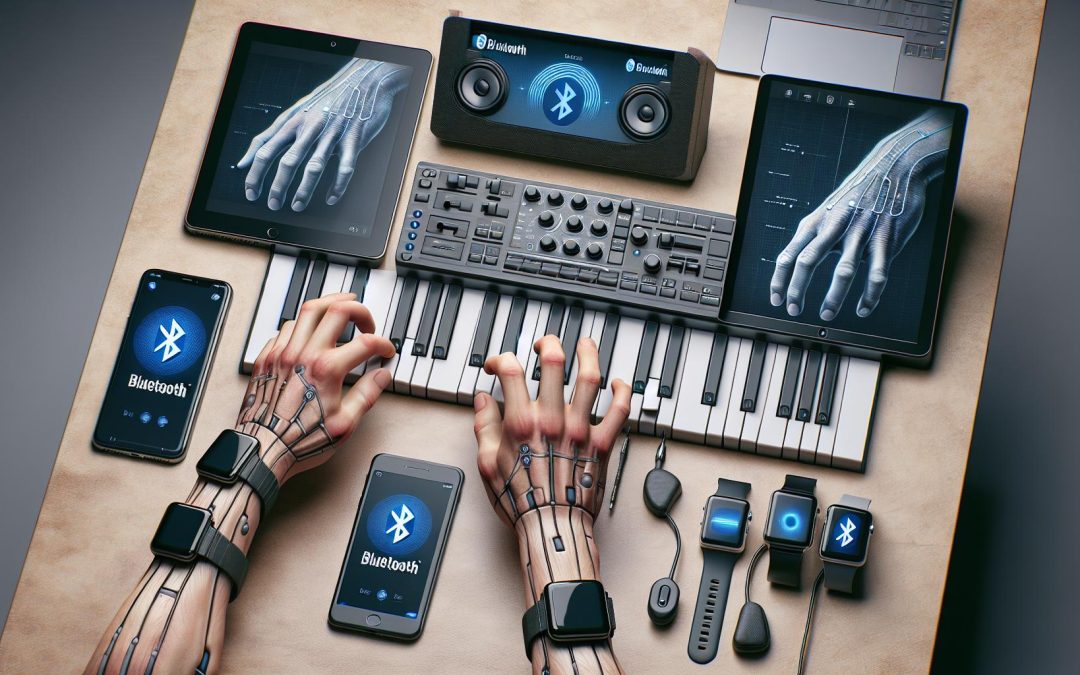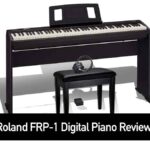Imagine a world where learning to play the piano is as easy as connecting your keyboard to your smartphone! That's the magic of a piano keyboard with Bluetooth connectivity. It's a game-changer for beginners, making the learning process more interactive and enjoyable.
These innovative keyboards aren't just about playing music. They're about immersing yourself in the world of music, exploring new melodies, and mastering your favorite tunes. They're designed with learners in mind, making them the perfect tool for anyone looking to dive into the world of piano.
Benefits of a Piano Keyboard with Bluetooth Connectivity
Convenience and Portability
That's right! One of the biggest benefits of a piano keyboard with Bluetooth connectivity lies in its convenience and portability. They're lightweight, compact, and don't require any physical connection to work. Users can bring them anywhere and even play, practice, or explore new melodies while in transit.
Interactivity and User Engagement
Not only are these keyboards useful in terms of transportation, but they've also got an edge when it comes to interactivity and user engagement. With Bluetooth connectivity, piano keyboards become more than just an instrument. They transform into an interactive learning tool that provides users with the chance to delve deeper into their music exploration.
With a piano keyboard that's Bluetooth-enabled, a player doesn't just perform music; they experience it. Connection to other devices, like tablets or smartphones, allows users to utilize various music apps, which can make their learning process more engaging and fun. They can play games, take online courses, or even partake in interactive lessons and tutorials.
Personalized Learning Experience
Truth be told, everyone's learning process is different. By using Bluetooth-enabled piano keyboards, beginners can tailor their learning experiences in a way that aligns with their individual needs. They can choose between a multitude of apps and find the one that best suits their learning style.
For instance, visual learners may prefer apps with graphics or video tutorials, while auditory learners might find applications with acoustic guides and sound-based games more beneficial.
Mastery of Favorite Tunes
Finally, one of the biggest perks when it comes to Bluetooth-enabled keyboards is the ability to master one's favorite tunes. By connecting their keyboard to their sound system, users can play along with their preferred songs any time they like.
Wirelessly linking their piano keyboard to a device with their music library enables players to perfect their skills, enhancing their musical repertoire and bringing them a step closer to becoming the pianists they aspire to be.
Convenience, interactivity, personalization, and the potentiality to master preferred tunes – these are the remarkable benefits that a piano keyboard with Bluetooth connectivity provides.
Features to Look for in a Bluetooth Piano Keyboard

When on the hunt for a Bluetooth piano keyboard, there are certain key features to keep in mind.
Bluetooth Version
Bluetooth technology has evolved over time, and it's crucial to check the version used in your potential keyboard. You'll want a device that uses Bluetooth 4.0 or later, as these versions offer better power efficiency, improved security, and noticeably faster data transfer speeds.
Compatibility
It's important to ensure that the keyboard is compatible with a variety of devices and operating systems. This might include tablets, smartphones, and computers running on Android, iOS, or Windows.
Keyboard Size and Weight
For the sake of portability and convenience, you'll want a keyboard that is lightweight and compact. That way, you can easily take it with you wherever you go.
Available Apps
Several piano keyboards can connect to a range of apps offering virtual lessons or sheet music. Exploring the apps available for use with each keyboard might enhance your piano playing experience.
Battery Life
Do check the battery life of the keyboard. If you fancy portable use, one with a longer battery life would come in handy.
Speaker Quality
The last but not the least is the quality of audio output. A good Bluetooth piano keyboard should have high-quality speakers that can faithfully reproduce the sounds of the piano.
How Bluetooth Connectivity Enhances the Learning Experience

Moving beyond the confines of traditional methods, learning piano has evolved dramatically with the advent of Bluetooth technology. Bluetooth connectivity in piano keyboards is much more than a mere convenience - it's a game-changer for learners.
Fueling flexibility, portable keyboards with Bluetooth allow students to practice their passion from virtually anywhere. They can set up their keyboard in their living room or take it on a road trip. Try to imagine practicing scales on a sunny beach! It's all possible due to the portability and connectivity of these devices.
Incorporating interactivity, Bluetooth-enabled keyboards interact with a multitude of musical apps. These apps transform the learning process into an engaging journey. They offer a wide range of guild-guided tutorials, interactive sheet music, and games. It's a great method of making practice sessions a lot more fun and interactive. It's also an effective way to keep them hooked and interested in their learning.
Providing a personalized learning experience is another significant advantage. Not everyone learns at the same pace or in the same way. Bluetooth piano keyboards embrace this concept and adapt to the individual learning style of each student. By pairing with apps that track progress, provide customized lessons, and offer constructive feedback, these keyboards make learning a truly unique experience tailored just for them.
Of course, to optimize the Bluetooth piano experience, it's important to consider a keyboard's key features. That's where aspects like Bluetooth version, compatibility with different devices, keyboard size and weight, available apps, battery life, and speaker quality play a major role. So, don't forget to keep an eye on these factors while making your deliberation.
No doubt, the impact of Bluetooth connectivity on learning piano is profound. It's an exciting time for music education where technology and creativity intertwine beautifully to create an inspiring learning journey. As the industry advances in leaps and bounds, it's clear that the future of piano learning is bright, fun, and exceedingly interactive.
Top Bluetooth Piano Keyboards for Beginners

In a world teeming with technology, it's challenging to figure out which tool is the best one that fits your needs. For a novice entering the world of music through piano, there are several Bluetooth piano keyboards designed explicitly with beginners in mind.
The Roland GO:PIANO is one of the top contenders. It's lightweight and compact, making it easily portable. Despite its size, it incorporates high-quality sounds derived from Roland's premium digital pianos. It also offers Bluetooth connectivity to connect with popular music education apps on mobile devices.
In contrast, if you're looking for a more traditional touch, consider the Yamaha EZ-220. This model consists of 61 touch-sensitive keys and 100+ preset songs. What sets it apart is its unique light-up key system that assists in learning songs. Again, Bluetooth compatibility comes in handy for interacting with a range of music programs.
For those who crave versatility and learning aids, the The ONE Smart Piano Keyboard shouldn't be overlooked. It boasts 61 keys and, as the name suggests, it is marked as "smart" due to the features like LED-guided learning and games from the comprehensive app.
The Alesis Recital is also worth noting. With premium sounds, powerful educational features, including Skoove, and complete wireless operation, it offers beginners everything they need to kickstart their musical journey.
One must remember! A keyboard's potential isn't entirely based on the features that meet the eye. It's about personal compatibility. The Bluetooth piano keyboard should match the learner's style and be something they feel comfortable and excited to use. As a beginner, it's beneficial when the keyboard aligns with their learning style and pace, taking their piano learning experience to new heights.
Tips for Choosing the Right Bluetooth Piano Keyboard

Selecting the perfect Bluetooth piano keyboard can feel like a daunting task. But don't worry. Here are a few tips to help you navigate your options and find the right fit for your needs.
Understand Your Needs
Before diving into the sea of options, it's essential to first understand your needs. Are you a complete beginner? Perhaps you're an advanced learner needing to practice more complex pieces? Identify your proficiency level and the features you desire in a keyboard.
Quality of Sound
An essential aspect to consider is the quality of sound. A keyboard with high-quality sound will mimic the richness and depth of an acoustic piano, providing a more authentic playing experience. Both the Roland GO:PIANO and Yamaha EZ-220 are known for their high-quality sound, making them great options.
Learning Features
Consider the learning features each keyboard offers. Light-up key systems and LED-guided learning such as those on The ONE Smart Piano Keyboard can be incredibly useful for visual learners. Look for powerful, interactive educational features that align with your learning style.
Compatibility
Is the keyboard compatible with your devices? With Bluetooth connectivity, your keyboard should effortlessly connect with your smart devices. Check if the keyboard is compatible with your iOS or Android device for a seamless experience.
Portability
Are you always on the move? If so, portability might be a key factor for you. A lightweight and portable keyboard like the Alesis Recital can be easily transported, turning any space into a practice room.
As you shop around, remember that the perfect Bluetooth piano keyboard is one that fits your personal needs and aligns with your learning style.
Conclusion
So, there you have it. Picking the right Bluetooth piano keyboard doesn't have to be a daunting task. It's all about knowing what you need, considering the sound quality, checking out the learning features, ensuring device compatibility, and thinking about portability. Remember, the perfect keyboard is one that suits you and your unique learning style. With these tips, you're well on your way to finding a keyboard that not only meets your needs but also makes learning to play the piano an enjoyable journey. Happy playing!
Harlan Kilstein began playing piano during covid with no piano background at all. He taught himself how to play learning what to do and what not to do.
Today he's an advanced intermediate player and can help you grow in your skills because he learned all this on his own.








